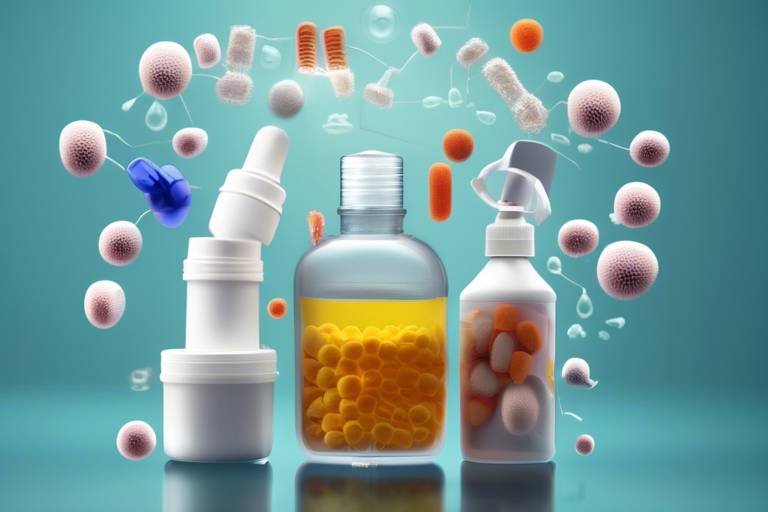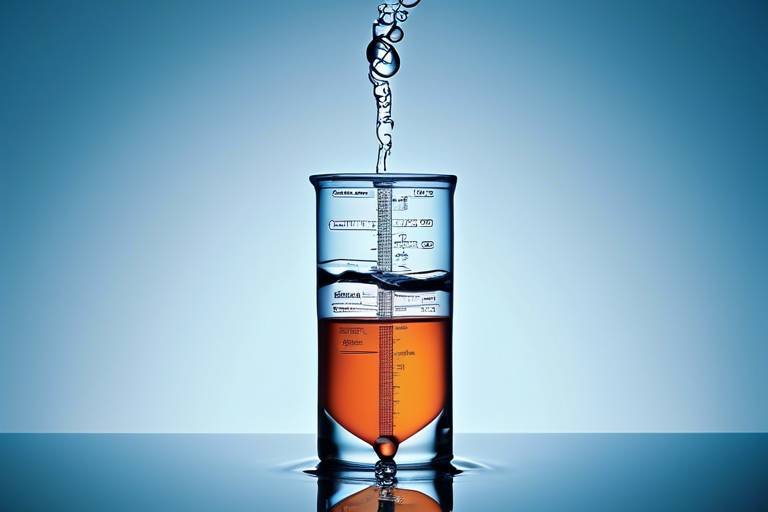The Role of Antimicrobials in Everyday Products
In our fast-paced world, the invisible battle against germs is constant, and antimicrobials have become our silent allies in this fight. From the moment we wake up and wash our hands to the time we settle down for the night, we are surrounded by products designed to keep us safe from harmful microorganisms. But what exactly are antimicrobials, and how do they fit into our daily lives? In this article, we will explore the integration of antimicrobials in various consumer products, their benefits, potential risks, and the ongoing debate regarding their safety and effectiveness in daily use. Buckle up, because this journey through the world of antimicrobials is going to be eye-opening!
Antimicrobials are substances that either kill or inhibit the growth of microorganisms, including bacteria, viruses, fungi, and parasites. They play a crucial role in maintaining public health by preventing infections and ensuring hygiene in various settings. There are several types of antimicrobials, including antibiotics, antiseptics, and disinfectants, each serving different purposes. For instance, antibiotics are commonly used in medicine to treat infections, while antiseptics are applied to skin surfaces to reduce the risk of infection during surgical procedures. Meanwhile, disinfectants are used on surfaces to eliminate pathogens. Understanding these distinctions is essential as they highlight the significance of antimicrobials in everyday products, from household cleaners to personal care items.
Many of us might not realize just how prevalent antimicrobials are in our daily lives. A typical household contains a variety of products infused with these agents, each designed with a specific purpose in mind. Here are some common products that utilize antimicrobials:
- Soaps and Body Washes: Many soaps claim to kill germs and provide a deeper clean.
- Kitchenware: Cutting boards and utensils often come with antimicrobial coatings to prevent bacterial growth.
- Textiles: Some clothing and linens are treated with antimicrobials to reduce odors and stains.
- Household Cleaners: Disinfectants and surface cleaners are formulated to kill germs on various surfaces.
These products not only contribute to a cleaner environment but also enhance our overall health and well-being. It's fascinating to think about how these tiny agents are working behind the scenes to keep our homes and bodies safe!
When it comes to washing our hands, antimicrobial soaps often take center stage. These soaps claim to reduce bacteria and viruses on our skin more effectively than regular soap. But do they really deliver on that promise? The effectiveness of antimicrobial soaps has been a topic of heated debate. While many consumers believe that using these products offers superior protection, research has shown that washing with plain soap and water is often just as effective in removing germs. This raises the question: are we relying too heavily on these specialized products?
Antimicrobial soaps typically contain active ingredients like triclosan and chlorhexidine. Triclosan, for example, works by disrupting the bacteria's ability to function and reproduce. However, concerns have been raised about its long-term safety and potential health implications. Chlorhexidine is another common ingredient, particularly in healthcare settings, known for its effectiveness against a broad spectrum of bacteria. However, overuse of these ingredients can lead to issues such as skin irritation and contribute to the growing problem of antimicrobial resistance.
In response to the controversies surrounding antimicrobial soaps, health authorities have established guidelines to regulate their use. The FDA has scrutinized these products, emphasizing the need for evidence supporting their efficacy and safety. Regulations dictate that manufacturers must provide data proving their claims, which impacts consumer safety and product labeling. It's vital for consumers to be informed about these regulations to make educated choices about the products they use daily.
Beyond soaps, antimicrobial coatings have emerged as a revolutionary solution in various industries. These coatings are applied to surfaces to prevent microbial growth, making them particularly valuable in healthcare, food service, and public spaces. By creating an inhospitable environment for pathogens, antimicrobial coatings play a crucial role in infection control. Imagine a hospital room where every surface is treated to resist bacteria—this innovation not only protects patients but also enhances the overall safety of medical environments.
The use of antimicrobials in products brings significant health benefits. First and foremost, they contribute to reduced infections, which is especially crucial in healthcare settings. Additionally, antimicrobials improve hygiene practices in everyday life, helping to keep our homes and communities safer. Moreover, products infused with antimicrobials often have enhanced longevity, as they resist degradation from microbial growth. This means less waste and a more sustainable approach to consumer goods.
Antimicrobials also play a pivotal role in public health initiatives. They help control disease outbreaks by promoting improved sanitation practices in communities. For instance, in the aftermath of a viral outbreak, the increased use of antimicrobial cleaning products can help mitigate the spread of pathogens. The integration of antimicrobials into everyday products is not just a convenience; it is a vital component in safeguarding community health.
As consumers, it's essential to educate ourselves about antimicrobials. Understanding product labels, recognizing the balance between safety and effectiveness, and making informed choices can empower us to use these products wisely. By being aware of what we are bringing into our homes, we can take proactive steps to protect ourselves and our families without falling prey to marketing gimmicks.
Despite the benefits, the use of antimicrobials is not without its concerns. One of the most pressing issues is antimicrobial resistance. This phenomenon occurs when microorganisms evolve to resist the effects of antimicrobials, rendering them ineffective. Misuse of these products in consumer settings can contribute to this growing global concern, posing significant implications for public health.
Antimicrobial resistance is a serious threat that could undermine decades of medical advancements. As we continue to use antimicrobials in everyday products, we must be cautious about how we do so. Over-reliance on these agents can lead to the emergence of resistant strains of bacteria, making infections harder to treat. This is a wake-up call for all of us to reconsider our approach to hygiene and product use.
Additionally, the environmental consequences of antimicrobial use are significant. These substances can leach into waterways, affecting ecosystems and wildlife. The importance of sustainable practices in product formulation cannot be overstated. It’s crucial for manufacturers to consider the long-term effects of their products on the environment and prioritize eco-friendly alternatives.
1. Are antimicrobial soaps more effective than regular soaps?
While antimicrobial soaps claim to be more effective, studies have shown that regular soap and water can be just as effective in removing germs.
2. What are the risks associated with using antimicrobial products?
The primary risks include antimicrobial resistance and potential skin irritation from certain active ingredients.
3. How can I make informed choices about antimicrobial products?
Educate yourself on product labels, understand the active ingredients, and consider the necessity of using antimicrobials in your daily routine.
4. What is the environmental impact of antimicrobials?
Antimicrobials can leach into the environment, affecting ecosystems and wildlife. Sustainable practices in product formulation are essential to mitigate these effects.

Understanding Antimicrobials
Antimicrobials are more than just a buzzword in the realm of health and hygiene; they are essential substances that play a pivotal role in our daily lives. These agents are designed to kill or inhibit the growth of microorganisms, including bacteria, viruses, fungi, and parasites. Imagine them as the tiny soldiers on the frontline of our defense against infectious diseases, working tirelessly to keep us safe. But what exactly are these substances, and how do they function in the products we use every day?
There are several types of antimicrobials, each with unique properties and mechanisms of action. The most common categories include:
- Antibiotics: These are used primarily to treat bacterial infections and are often prescribed by healthcare professionals.
- Antiseptics: Found in hand sanitizers and wound care products, these agents help reduce the risk of infection by killing microorganisms on the skin.
- Disinfectants: These are used on surfaces to eliminate pathogens, making them crucial in settings like hospitals and kitchens.
- Preservatives: Often found in personal care products and food items, preservatives prevent microbial growth, extending shelf life.
Understanding how these antimicrobials function is key to appreciating their significance. For instance, when you wash your hands with an antimicrobial soap, the active ingredients work to disrupt the cellular processes of bacteria, rendering them inactive. This process not only helps to keep your hands clean but also reduces the risk of spreading infections. In a world where germs are ubiquitous, these products can be a game-changer in maintaining public health.
However, the conversation surrounding antimicrobials isn't just about their benefits. It's also crucial to consider their implications on health and the environment. As we embrace these powerful agents, we must also be aware of their potential risks, such as the development of antimicrobial resistance. This phenomenon occurs when microorganisms evolve to resist the effects of antimicrobials, making infections harder to treat. Balancing the use of these substances with responsible practices is essential for ensuring their continued effectiveness and safety.
In summary, antimicrobials are vital in our fight against infections, found in various products we encounter daily. Their ability to kill or inhibit microbes helps us maintain hygiene and health. Nevertheless, as we utilize these powerful tools, we must remain informed about their effects and the importance of responsible usage. After all, knowledge is power, and understanding antimicrobials can help us make better choices for our health and the environment.

Common Products Containing Antimicrobials
In our fast-paced world, it's hard to imagine a day without interacting with products that contain antimicrobials. From the moment you wash your hands to the time you cook dinner, these invisible warriors are hard at work, helping to keep us safe from harmful microorganisms. But what exactly are these products? They range from everyday items like soaps and sanitizers to more specialized applications in kitchenware and textiles. Each of these products harnesses the power of antimicrobials to provide enhanced protection against bacteria and viruses, making them indispensable in our daily lives.
Let's start with the most common product: antimicrobial soaps. These soaps are specifically formulated to reduce the number of bacteria and viruses on our skin. They often contain active ingredients like triclosan or chlorhexidine, which are designed to target and kill harmful microbes. However, the effectiveness of these soaps compared to regular soap has been a hot topic of debate. While they do provide an extra layer of protection, some health experts argue that regular soap and water are just as effective when used properly.
But soaps are just the tip of the iceberg. You might be surprised to learn that kitchenware items, such as cutting boards and utensils, often come with antimicrobial coatings. These coatings are engineered to inhibit microbial growth, ensuring that your food preparation surfaces remain hygienic. This is especially critical in preventing cross-contamination, which can lead to foodborne illnesses. Imagine chopping raw chicken on a surface that actively fights bacteria—sounds reassuring, doesn’t it?
Another area where antimicrobials shine is in textiles. From clothing to bed linens, many fabrics are treated with antimicrobial agents to reduce odor and maintain freshness. This is particularly beneficial for athletic wear, which is notorious for harboring bacteria that cause unpleasant smells. By incorporating antimicrobials into fabrics, manufacturers can offer products that not only look good but also provide a level of hygiene that appeals to health-conscious consumers.
Additionally, antimicrobial coatings are increasingly being applied to surfaces in various industries. Hospitals, for example, have adopted these technologies to reduce the risk of hospital-acquired infections. By applying antimicrobial agents to surfaces like doorknobs, bed rails, and medical equipment, healthcare facilities aim to create a safer environment for patients and staff alike. It's like having a protective shield that works continuously, even when the staff is busy attending to other tasks.
In summary, antimicrobials are integrated into a wide variety of products that we use every day. Their presence in soaps, kitchenware, textiles, and coatings reflects their importance in enhancing hygiene and safety. However, as we embrace these advancements, it’s essential to remain informed about their effectiveness and the ongoing discussions surrounding their use. The balance between leveraging their benefits and understanding their limitations is critical in making informed choices for ourselves and our families.
- What are antimicrobials? Antimicrobials are substances that kill or inhibit the growth of microorganisms, including bacteria, viruses, and fungi.
- Are antimicrobial products more effective than regular products? While antimicrobial products can offer additional protection, regular soap and water are often just as effective when used properly.
- What are some common antimicrobial ingredients? Common ingredients include triclosan, chlorhexidine, and silver ions, which are used in various consumer products.
- Do antimicrobial coatings have an impact on health? Antimicrobial coatings can help reduce the spread of infections, particularly in healthcare settings, but their long-term effects are still being studied.

Antimicrobial Soaps
When it comes to keeping our hands clean, antimicrobial soaps have become a popular choice. These soaps boast the ability to reduce bacteria and viruses on the skin, making them a go-to for many households, especially during cold and flu season. But how effective are they really? The effectiveness of antimicrobial soaps compared to regular soap is a hot topic, and it’s essential to peel back the layers to understand what’s at stake.
Antimicrobial soaps typically contain specific active ingredients designed to target and kill harmful microorganisms. These soaps are marketed with promises of superior protection, often leading consumers to believe they are making a better choice for hygiene. However, studies have shown that regular soap and water are often just as effective when it comes to removing dirt and bacteria from hands. So, why do we continue to reach for these specialized products? Perhaps it’s the allure of feeling safer and cleaner, or maybe it’s the clever marketing that convinces us that we need this extra layer of protection.
One of the most significant ingredients found in many antimicrobial soaps is triclosan. This chemical has been a subject of controversy, with debates surrounding its effectiveness and safety. While it does have antimicrobial properties, research has raised concerns about its potential health risks, including hormonal disruptions and contributing to antibiotic resistance. Another common ingredient is chlorhexidine, which is often used in healthcare settings for its strong antibacterial properties. However, the question remains: are these ingredients necessary for everyday use?
As consumers, it’s crucial to be aware of what we’re using on our bodies. The FDA has taken steps to evaluate the safety and effectiveness of these antimicrobial agents, leading to stricter regulations regarding their use. Many manufacturers have been forced to reformulate their products or remove certain ingredients entirely. This regulatory scrutiny aims to ensure that consumers are not only safe but also well-informed about the products they choose.
In summary, while antimicrobial soaps offer a sense of security and cleanliness, it's essential to weigh their benefits against potential risks. Regular soap and water remain incredibly effective for handwashing, and understanding the ingredients in our soaps can help us make informed choices. So the next time you reach for that fancy antimicrobial soap, ask yourself: is it really necessary, or is it just a marketing gimmick?
- Are antimicrobial soaps more effective than regular soap?
Research indicates that regular soap and water are just as effective at removing dirt and germs. - What are the risks associated with using antimicrobial soaps?
Some ingredients, like triclosan, have been linked to potential health risks, such as hormonal disruptions and antibiotic resistance. - Should I stop using antimicrobial soaps altogether?
It may be beneficial to use them sparingly and prioritize regular soap and water for daily handwashing.

Active Ingredients in Soaps
When it comes to antimicrobial soaps, the active ingredients play a pivotal role in their effectiveness. These substances are designed to kill or inhibit the growth of harmful microorganisms, providing an extra layer of protection against germs. Among the most common active ingredients found in these soaps are triclosan and chlorhexidine, each with its own unique mechanism of action and associated benefits.
Triclosan is perhaps the most well-known antimicrobial agent, frequently marketed as a powerful antibacterial component. It works by disrupting the lipid synthesis in bacterial cell membranes, ultimately leading to cell death. However, its widespread use has sparked debates over its safety. Some studies suggest that triclosan may contribute to the development of antibiotic-resistant bacteria, raising concerns about its long-term efficacy. Additionally, there is growing evidence that triclosan can have detrimental effects on aquatic ecosystems, as it can persist in the environment and accumulate in the food chain.
Chlorhexidine, on the other hand, is a broad-spectrum antimicrobial agent often used in clinical settings. It is effective against a wide variety of bacteria, viruses, and fungi. Chlorhexidine works by disrupting the cell membranes of these microorganisms, leading to their death. This ingredient is commonly found in surgical scrubs and hand sanitizers, highlighting its importance in infection control. However, while chlorhexidine is generally considered safe for use in health care settings, it can cause skin irritation in some individuals when used in higher concentrations.
In addition to these two prominent ingredients, there are other antimicrobial agents worth mentioning, such as benzalkonium chloride and iodine-based compounds. Benzalkonium chloride is often used in disinfectant wipes and sprays due to its ability to kill a wide range of pathogens. Iodine-based compounds, like povidone-iodine, are frequently employed in surgical settings for their potent antiseptic properties. These ingredients, while effective, also come with their own sets of risks and benefits.
It’s essential for consumers to be aware of what’s in their soaps and to understand the implications of these ingredients. While the promise of antimicrobial protection is enticing, it’s crucial to balance this with an understanding of potential health risks. As you shop for soaps, take a moment to read the labels and consider the active ingredients. Are they truly necessary for your daily hygiene routine, or could traditional soap and water suffice? The answer may vary from person to person, but being informed is always a wise choice.
In summary, the active ingredients in antimicrobial soaps are designed to provide enhanced protection against germs, but they come with a mix of benefits and concerns. As consumers, we must navigate these waters carefully, weighing the effectiveness of these ingredients against their potential risks to both health and the environment.
- Are antimicrobial soaps more effective than regular soaps?
In general, regular soap and water are effective in removing dirt and germs. Antimicrobial soaps may provide additional protection, but their necessity varies based on individual circumstances. - What are the risks associated with using triclosan?
Triclosan has been linked to antibiotic resistance and potential environmental harm, which raises concerns about its widespread use in consumer products. - Can I use antimicrobial soaps every day?
While antimicrobial soaps can be used daily, it’s important to consider if they are necessary for your hygiene routine. Overuse may lead to skin irritation or other issues. - What should I look for when choosing an antimicrobial soap?
Look for clear labeling of active ingredients, consider your skin type, and weigh the benefits against potential risks. Consulting with a healthcare professional can also be helpful.

Regulatory Perspectives
When it comes to antimicrobials, regulation is a critical component that ensures consumer safety and product efficacy. Various health authorities around the world, including the U.S. Environmental Protection Agency (EPA) and the Food and Drug Administration (FDA), play significant roles in overseeing the use of these substances in consumer products. Their guidelines are designed to protect public health while also allowing for the innovation and development of new antimicrobial products.
The regulatory framework for antimicrobials can be complex, as it involves multiple layers of oversight. For example, the FDA regulates antimicrobial soaps as over-the-counter drugs, which means they must undergo rigorous testing to demonstrate their safety and effectiveness before they can be marketed. In contrast, antimicrobial coatings used in various industries, such as healthcare and food service, are often subject to different regulations that may focus more on efficacy rather than safety.
Here’s a brief overview of the regulatory process:
| Regulatory Body | Focus Area | Key Regulations |
|---|---|---|
| FDA | Antimicrobial Soaps | Over-the-counter drug regulations |
| EPA | Antimicrobial Coatings | Registration of pesticide products |
| CDC | Public Health Guidelines | Infection control recommendations |
Moreover, product labeling is another crucial aspect of regulation. Consumers have the right to know what they are using, and clear labeling helps them make informed choices. Labels must accurately reflect the antimicrobial properties of a product and disclose any potential risks associated with its use. This transparency not only fosters consumer trust but also encourages responsible usage of antimicrobial products.
However, the regulatory landscape is not without its challenges. As new antimicrobial agents are developed, regulators must continuously adapt their guidelines to address emerging science and technology. This ongoing evolution raises questions about the adequacy of current regulations and whether they sufficiently address the potential risks associated with antimicrobial use.
In summary, the regulatory perspectives surrounding antimicrobials are vital for ensuring that these products are both safe and effective. As consumers, it’s essential to stay informed about these regulations, as they directly impact the products we use in our daily lives. Understanding the regulatory framework can empower consumers to make better choices and advocate for their health and safety.
- What are antimicrobials? Antimicrobials are substances that kill or inhibit the growth of microorganisms, including bacteria, viruses, and fungi.
- Are antimicrobial products safe to use? While many antimicrobial products are considered safe when used as directed, it's important to be aware of potential risks and regulatory guidelines.
- How can I identify antimicrobial products? Look for labels that indicate antimicrobial properties, and check for active ingredients that are known to have antimicrobial effects.
- What is the role of the FDA and EPA in regulating antimicrobials? The FDA regulates antimicrobial soaps as over-the-counter drugs, while the EPA oversees antimicrobial coatings and other pesticide products.
- What are the environmental impacts of antimicrobials? Antimicrobials can affect ecosystems, so sustainable practices in product formulation are essential to minimize their environmental footprint.

Antimicrobial Coatings
Antimicrobial coatings are becoming increasingly prevalent in various industries, acting as a protective barrier against harmful microorganisms. These coatings are designed to be applied to surfaces, providing a long-lasting defense that inhibits the growth of bacteria, fungi, and viruses. Imagine walking into a hospital where every surface, from the doorknobs to the countertops, is treated with a coating that actively fights germs. This is not just a dream; it’s a reality made possible by advancements in antimicrobial technology.
In the healthcare sector, antimicrobial coatings play a vital role in infection control. Hospitals are hotbeds for infections, and the introduction of these coatings can significantly reduce the risk of healthcare-associated infections (HAIs). For instance, surgical instruments, bed rails, and even walls can be treated with these coatings, creating an environment that is less hospitable to pathogens. The effectiveness of these coatings lies in their ability to release antimicrobial agents over time, ensuring continuous protection.
Beyond healthcare, antimicrobial coatings are also making waves in the food service industry. Food preparation surfaces, utensils, and storage containers can benefit from these coatings, helping to maintain hygiene standards and extend the shelf life of food products. By preventing microbial contamination, these coatings not only protect consumer health but also reduce food waste, which is a significant concern in today's world.
However, the application of antimicrobial coatings is not limited to just healthcare and food service. They are also finding their way into everyday products, such as smartphones, kitchenware, and textiles. For example, imagine your cutting board actively fighting off bacteria while you prepare your meals. This is the promise of antimicrobial coatings, making our daily lives safer and more hygienic.
Despite their advantages, it's essential to consider the materials used in these coatings. The effectiveness and safety of antimicrobial coatings can vary widely based on the active ingredients employed. Some common agents include silver ions, copper, and zinc, each with its unique mechanism of action. For instance, silver ions disrupt bacterial cell membranes, leading to cell death, while copper has been shown to have a similar effect. Understanding these mechanisms helps consumers make informed choices about the products they use.
As the demand for antimicrobial coatings continues to rise, regulatory bodies are stepping in to ensure safety and effectiveness. Guidelines are being established to govern the use of these coatings in consumer products, balancing the need for hygiene with potential health implications. It's crucial for manufacturers to adhere to these regulations to ensure that the coatings are not only effective but also safe for everyday use.
In summary, antimicrobial coatings are a fascinating intersection of technology and health, providing a proactive approach to infection control across various sectors. As consumers, being aware of these innovations can empower us to make smarter choices when it comes to the products we use in our homes and workplaces. The future looks bright as we continue to explore the potential of antimicrobial coatings in enhancing our quality of life.

Benefits of Antimicrobial Use
When it comes to our health and well-being, the in everyday products cannot be overstated. These powerful agents play a crucial role in reducing the risk of infections and enhancing hygiene in our daily lives. Imagine walking into a public restroom or a crowded kitchen; the last thing you want is to come into contact with harmful bacteria or viruses. This is where antimicrobials shine, acting as a protective shield that helps keep us safe from unseen threats.
One of the most significant advantages of using antimicrobials is the reduction of infections. By incorporating these substances into products like soaps, hand sanitizers, and even kitchenware, we can dramatically lower the chances of bacteria multiplying and causing illnesses. For instance, studies have shown that antimicrobial soaps can reduce the presence of harmful microbes on our skin, leading to fewer cases of foodborne illnesses and skin infections. It's like having an invisible guardian that works tirelessly to keep us healthy.
Moreover, the use of antimicrobials contributes to improved hygiene practices in both personal and public settings. In hospitals, for example, antimicrobial coatings on surfaces help prevent the spread of infections among patients and healthcare workers. This is particularly vital in environments where vulnerable individuals are present, as even a small oversight can lead to serious consequences. The enhanced hygiene provided by these products not only protects individuals but also promotes a healthier community overall.
Another noteworthy benefit is the enhanced product longevity. Antimicrobials can prevent the growth of mold, mildew, and bacteria on various surfaces, extending the life of products. For instance, antimicrobial-treated fabrics in clothing and upholstery resist odor and staining, making them last longer and remain fresher. This not only saves consumers money in the long run but also reduces waste, contributing to a more sustainable lifestyle.
To illustrate these benefits, consider the following table that summarizes the advantages of antimicrobial use across different sectors:
| Sector | Benefits |
|---|---|
| Healthcare | Reduces hospital-acquired infections, protects vulnerable patients |
| Food Service | Prevents food contamination, promotes food safety |
| Household | Improves hygiene, reduces odors, extends product life |
In conclusion, the benefits of antimicrobial use are multifaceted, ranging from enhanced hygiene and infection control to improved product longevity. As we navigate through our daily routines, it's essential to recognize the value that these substances bring to our lives. However, it’s equally important to remain informed and make educated choices regarding the products we use. Understanding the balance between safety and effectiveness will empower consumers to harness the full potential of antimicrobials without compromising their health or the environment.
- What are antimicrobials? Antimicrobials are substances that kill or inhibit the growth of microorganisms, including bacteria, viruses, and fungi.
- Are antimicrobial products safe to use? Generally, antimicrobial products are safe when used as directed. However, it's essential to be aware of potential risks and follow guidelines.
- How do antimicrobials help in public health? They help reduce the spread of infections, contribute to improved hygiene standards, and play a crucial role in controlling disease outbreaks.
- Can the use of antimicrobials lead to resistance? Yes, overuse or misuse of antimicrobials can contribute to antimicrobial resistance, which is a growing global concern.

Impact on Public Health
The impact of antimicrobials on public health is profound and multifaceted. These substances play a crucial role in controlling the spread of infectious diseases, which is especially important in today's world where global travel and urbanization have increased the risk of outbreaks. By effectively reducing the presence of harmful microorganisms on surfaces and in products, antimicrobials help to create a healthier environment for everyone. Imagine walking into a hospital where every surface is treated with antimicrobial coatings; it’s like stepping into a fortress against germs!
One of the most significant contributions of antimicrobials is their role in infection control. In healthcare settings, the use of antimicrobial soaps and coatings has been instrumental in preventing hospital-acquired infections (HAIs), which can be deadly. According to the Centers for Disease Control and Prevention (CDC), HAIs affect approximately 1 in 31 hospital patients on any given day. By incorporating antimicrobials into everyday products, we can significantly reduce these alarming statistics and promote better health outcomes.
Moreover, the use of antimicrobials extends beyond hospitals. They are increasingly found in various consumer products, from kitchenware to clothing, enhancing hygiene in our daily lives. For instance, antimicrobial kitchen sponges can inhibit the growth of bacteria, making food preparation safer. This proactive approach to hygiene is akin to having an invisible shield that protects us from unseen threats.
However, the benefits of antimicrobials in public health are not limited to infection prevention. They also contribute to improved sanitation practices within communities. In areas where access to clean water and sanitation facilities is limited, antimicrobials can help mitigate the risks associated with poor hygiene. By using antimicrobial products, communities can reduce the transmission of diseases such as cholera and dysentery, ultimately saving lives.
Education plays a pivotal role in maximizing the benefits of antimicrobials. Consumers must understand how to use these products effectively and responsibly. By being informed about product labels and the specific benefits of antimicrobials, individuals can make choices that enhance their health and well-being. For example, knowing when to use antimicrobial soap versus regular soap can make a significant difference in preventing illness.
In summary, the impact of antimicrobials on public health is undeniable. They not only help control the spread of infections but also promote better hygiene practices and enhance the overall quality of life. As we continue to navigate a world filled with microbial threats, understanding and utilizing antimicrobials effectively will be essential in safeguarding our health.
- What are antimicrobials? Antimicrobials are substances that kill or inhibit the growth of microorganisms, helping to prevent infections and maintain hygiene.
- How do antimicrobials contribute to public health? They play a significant role in controlling disease outbreaks, reducing hospital-acquired infections, and promoting overall community health.
- Are there any risks associated with the use of antimicrobials? Yes, concerns include antimicrobial resistance and environmental impact, which are important to consider when using these products.
- How can consumers make informed choices about antimicrobial products? By understanding product labels and the specific benefits of antimicrobials, consumers can choose products that enhance their health and safety.

Consumer Awareness and Education
In today's world, where health and hygiene are paramount, consumer awareness regarding antimicrobials is more crucial than ever. With the vast array of products available on the market, it's essential for consumers to understand what they are using and the implications of those choices. Many people might not even realize that everyday items like hand soaps, kitchenware, and even clothing can contain antimicrobials. This lack of knowledge can lead to misuse or over-reliance on these products, which is why education plays a vital role in promoting safe and effective use.
One of the first steps towards enhancing consumer awareness is understanding product labels. When shopping, consumers should look for specific information regarding antimicrobial ingredients. For instance, terms like “antibacterial” or “antimicrobial” should be clearly stated, along with any active ingredients. Knowing what is in a product can help individuals make informed decisions. Moreover, understanding the difference between regular soaps and antimicrobial soaps can guide consumers to choose the right product for their needs. Regular soap is effective at removing dirt and germs through mechanical action, while antimicrobial soaps are designed to kill or inhibit the growth of bacteria. However, the effectiveness of antimicrobial soaps over regular soap is still a topic of debate.
Additionally, educating consumers about the potential risks associated with overusing antimicrobials is essential. For example, the overuse of these products can contribute to antimicrobial resistance, a growing global health concern. This phenomenon occurs when microorganisms evolve to resist the effects of antimicrobial agents, rendering them less effective over time. As consumers, being aware of this issue can lead to more responsible usage, such as opting for regular soap when appropriate and reserving antimicrobial products for situations where they are genuinely needed.
To further enhance consumer education, public health campaigns can play a significant role. These campaigns can provide valuable information through various channels, including social media, community workshops, and educational brochures. By disseminating knowledge about the proper use of antimicrobials and their potential impacts, consumers are empowered to make better choices. For instance, understanding that not every surface requires an antimicrobial treatment can help reduce unnecessary exposure to these substances.
Moreover, as consumers become more knowledgeable, they can advocate for better regulations and transparency from manufacturers. This demand for accountability can lead to improved labeling practices and the development of safer products. In this way, consumer awareness not only benefits individuals but can also drive positive changes within the industry.
In conclusion, fostering consumer awareness and education about antimicrobials is vital in navigating the complexities of modern hygiene products. By understanding what’s in the products we use, recognizing the balance between safety and effectiveness, and advocating for transparency, consumers can make informed choices that support both personal health and public safety.
- What are antimicrobials? Antimicrobials are substances that kill or inhibit the growth of microorganisms, including bacteria, viruses, and fungi.
- Are antimicrobial soaps more effective than regular soaps? While antimicrobial soaps are designed to kill germs, regular soaps are effective at removing dirt and bacteria through washing action. The choice depends on the situation.
- What is antimicrobial resistance? Antimicrobial resistance occurs when microorganisms evolve to resist the effects of antimicrobial agents, making infections harder to treat.
- How can I make informed choices about antimicrobial products? Look for clear labeling on products, understand the active ingredients, and be aware of the potential risks associated with overuse.

Concerns and Controversies
While the integration of antimicrobials into everyday products has been lauded for its potential health benefits, it has also sparked a flurry of concerns and controversies that cannot be ignored. One of the most pressing issues is the phenomenon of antimicrobial resistance. This occurs when microorganisms evolve to resist the effects of antimicrobial agents, making infections harder to treat. The misuse of antimicrobials in consumer products, such as soaps and cleaning agents, may contribute to this alarming trend. As these products become commonplace in households, the risk of developing resistant strains of bacteria increases, posing a significant threat to public health.
The environmental impact of antimicrobials is another area of concern. When these substances are washed off and enter our water systems, they can disrupt aquatic ecosystems. Studies have shown that residues from antimicrobial products can have detrimental effects on fish and other aquatic life, leading to a decline in biodiversity. As consumers, we may not always consider how our choices affect the environment, but the reality is that the products we use daily can have far-reaching implications.
Moreover, the debate over the necessity of antimicrobials in everyday products continues to rage. Critics argue that the widespread use of these agents in items like household cleaners and personal care products may not be warranted, especially when regular soap and water can effectively remove dirt and germs. This raises the question: are we over-relying on antimicrobials? The potential for causing harm through overuse is a valid concern, and it pushes us to re-evaluate our cleaning habits and the products we choose.
In light of these controversies, it's essential for consumers to stay informed. Understanding the labels on products and recognizing the balance between safety and effectiveness can empower individuals to make better choices. Here are some key points to consider:
- Always check the active ingredients in antimicrobial products.
- Be aware of the potential for developing resistance through overuse.
- Consider environmentally friendly alternatives when possible.
As we navigate the complexities surrounding antimicrobials, it's crucial to engage in ongoing conversations about their role in our lives. Balancing the benefits of improved hygiene with the potential risks of resistance and environmental harm is a challenge that requires collective awareness and action.
Q: What are antimicrobials?
A: Antimicrobials are substances that kill or inhibit the growth of microorganisms, including bacteria, viruses, and fungi. They are commonly found in various consumer products.
Q: Why are antimicrobials used in everyday products?
A: Antimicrobials are used to enhance hygiene, reduce the risk of infections, and prolong the shelf life of products by preventing microbial growth.
Q: What are the risks associated with antimicrobial use?
A: The main risks include the development of antimicrobial resistance, potential negative impacts on the environment, and the debate over whether their use is necessary in all products.
Q: How can I make informed choices about antimicrobial products?
A: Read product labels carefully, understand the active ingredients, and consider using alternatives that do not contain antimicrobials when appropriate.

Antimicrobial Resistance
Antimicrobial resistance (AMR) is an escalating global crisis that poses a significant threat to public health. It occurs when microorganisms such as bacteria, viruses, fungi, and parasites evolve and develop the ability to resist the effects of medications that once effectively eliminated them. This means that common infections could become harder to treat, leading to longer hospital stays, higher medical costs, and increased mortality. The misuse and overuse of antimicrobials in various settings, including household products, agriculture, and healthcare, have been pivotal in this alarming trend.
In the context of consumer products, the frequent use of antimicrobials in soaps, sanitizers, and other household items can inadvertently contribute to the development of resistant strains of bacteria. When these products are used excessively, they create an environment where only the strongest microorganisms survive, leading to a cycle of resistance. For example, if a soap containing triclosan is used regularly, the bacteria that are susceptible to it may die off, while those that have developed resistance can thrive and multiply. This process not only diminishes the effectiveness of these products but also poses a risk of spreading resistant infections.
To understand the implications of AMR, consider the following key points:
- Increased Healthcare Costs: Treating resistant infections often requires more expensive medications, longer hospital stays, and additional tests, placing a financial burden on healthcare systems.
- Impact on Medical Procedures: Many medical procedures, such as surgeries and chemotherapy, rely on effective antimicrobials to prevent infections. The rise of resistant strains could jeopardize the safety of these procedures.
- Global Health Threat: AMR knows no borders; it can spread rapidly across nations through travel, trade, and even the environment, making it a global health concern.
Addressing antimicrobial resistance requires a multifaceted approach. Public awareness and education play crucial roles in combating this issue. Consumers must be informed about the potential risks associated with the overuse of antimicrobial products and encouraged to make judicious choices. Moreover, regulatory bodies are increasingly focusing on establishing guidelines that limit the use of certain antimicrobials in consumer products, promoting safer alternatives that do not contribute to resistance.
In summary, while antimicrobials serve a vital purpose in maintaining hygiene and preventing infections, their misuse can lead to severe consequences, such as antimicrobial resistance. It is essential for consumers, healthcare providers, and policymakers to collaborate in fostering responsible use and ensuring that these life-saving products remain effective for future generations.
What is antimicrobial resistance?
Antimicrobial resistance occurs when microorganisms evolve to resist the effects of medications that were previously effective against them, making infections harder to treat.
How does the use of antimicrobial products contribute to resistance?
Frequent use of antimicrobial products can create an environment where only resistant strains of bacteria survive, leading to a cycle of resistance.
What are the consequences of antimicrobial resistance?
AMR can lead to increased healthcare costs, impact the safety of medical procedures, and pose a significant global health threat.
How can consumers help combat antimicrobial resistance?
Consumers can help by using antimicrobial products judiciously, understanding product labels, and opting for alternatives that do not contribute to resistance.

Environmental Impact
The use of antimicrobials in consumer products is a double-edged sword, offering benefits while simultaneously posing significant environmental challenges. As these substances find their way into our ecosystems, they can lead to unintended consequences that affect both wildlife and human health. One of the major concerns is the accumulation of antimicrobials in water systems, which can disrupt aquatic life. For instance, when antimicrobial-laden soaps and cleaning agents are washed down the drain, they enter wastewater treatment facilities. Unfortunately, not all antimicrobials are effectively removed during treatment, allowing them to seep into rivers and oceans, where they can alter the natural balance of microbial communities.
Moreover, the presence of these chemicals can lead to the development of resistant strains of bacteria in the environment. When bacteria are continuously exposed to low levels of antimicrobials, they can adapt and develop resistance, making them harder to eliminate. This phenomenon not only threatens the effectiveness of these products but also poses a significant risk to public health. The World Health Organization (WHO) has warned that antimicrobial resistance could lead to a future where common infections become untreatable, thus highlighting the urgency of addressing this issue.
Another critical aspect of the environmental impact of antimicrobials is their potential to disrupt ecosystems. Antimicrobials can affect the biodiversity of microbial communities, which play essential roles in nutrient cycling and the overall health of ecosystems. The alteration of these communities can have cascading effects on larger organisms, including fish and other wildlife that depend on these microorganisms for food and habitat stability.
To illustrate the potential environmental consequences of antimicrobial use, consider the following table that summarizes key impacts:
| Impact | Description |
|---|---|
| Water Contamination | Antimicrobials enter water systems through wastewater, affecting aquatic life. |
| Antimicrobial Resistance | Continuous exposure leads to resistant bacteria, threatening public health. |
| Disruption of Ecosystems | Alteration of microbial communities impacts biodiversity and ecosystem health. |
In light of these challenges, it is crucial to adopt sustainable practices in the formulation and use of antimicrobial products. This includes developing biodegradable alternatives and ensuring that products are used judiciously to minimize environmental impact. As consumers, we can play a part by choosing products that are labeled as eco-friendly and being mindful of our consumption patterns. Ultimately, the goal is to strike a balance between the benefits of antimicrobial use and the protection of our precious ecosystems.
Q: What are antimicrobials?
A: Antimicrobials are substances that kill or inhibit the growth of microorganisms, including bacteria, viruses, and fungi.
Q: How do antimicrobials affect the environment?
A: Antimicrobials can contaminate water systems, disrupt ecosystems, and contribute to the development of antimicrobial-resistant bacteria.
Q: What can consumers do to minimize the environmental impact of antimicrobials?
A: Consumers can choose eco-friendly products, use antimicrobials sparingly, and support regulations that promote sustainable practices.
Frequently Asked Questions
- What are antimicrobials and how do they work?
Antimicrobials are substances that kill or inhibit the growth of microorganisms, such as bacteria, viruses, and fungi. They work by targeting specific components of microbial cells, disrupting their functions, and ultimately leading to cell death or growth inhibition. You can think of them as tiny soldiers protecting us from harmful invaders!
- Are antimicrobial soaps more effective than regular soaps?
While antimicrobial soaps claim to reduce bacteria and viruses on the skin, studies suggest that they may not be significantly more effective than regular soap and water. The key to effective handwashing is not just the soap type, but the technique and duration of washing. It's like comparing a fancy sports car to a reliable sedan; both can get you where you need to go, but the driver makes all the difference!
- What are some common products that contain antimicrobials?
Antimicrobials are found in a variety of everyday products, including soaps, kitchenware, cleaning supplies, and even clothing. They are designed to enhance hygiene and prevent microbial growth, making them a common feature in modern life. Just look around your home; you might be surprised at how many items are equipped with these protective agents!
- What are the potential risks associated with antimicrobial use?
Despite their benefits, the use of antimicrobials raises concerns such as antimicrobial resistance, environmental impact, and the debate over their necessity in everyday products. Overuse can lead to resistant strains of bacteria, making infections harder to treat. It's a bit like overusing a powerful tool; while it can be beneficial, too much can lead to unintended consequences.
- How can consumers make informed choices about antimicrobial products?
Consumers can make informed choices by educating themselves about product labels and understanding the active ingredients. It's important to weigh the benefits against potential risks. Think of it as reading the fine print before signing a contract; knowing what you're getting into can save you a lot of trouble down the line!
- What role do antimicrobials play in public health?
Antimicrobials contribute significantly to public health initiatives by controlling disease outbreaks and promoting better sanitation practices. They help reduce the spread of infections, much like a well-organized defense system in a community, ensuring that everyone stays safe and healthy.
- How does antimicrobial resistance occur?
Antimicrobial resistance occurs when microorganisms evolve and become resistant to the effects of antimicrobials. This can happen due to overuse or misuse of these products, leading to a situation where common infections become harder to treat. It's a bit like a game of whack-a-mole; the more you hit down one resistant strain, the more keep popping up!
- What environmental impacts are associated with antimicrobial use?
The environmental consequences of antimicrobial use can be significant, as these substances can affect ecosystems and disrupt the balance of natural microbial communities. It's crucial to adopt sustainable practices in product formulation to minimize harm to our planet. Think of it as keeping our backyard clean; we need to be mindful of what we put on it to protect the environment!



















